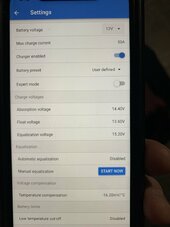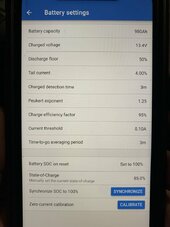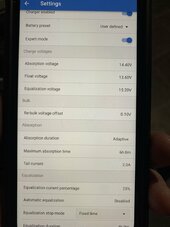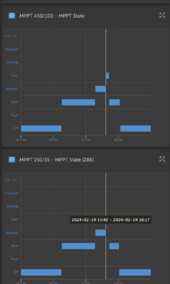@Adam De Lay
Wow!!! How do I answer to that?
I appreciate all your knowledgeable answers and like a lot of people here we don’t have the same depth of knowledge. Regards of answering the same question more than once I apologize that you felt it necessary for you to reply like this or even reply!!!
Every once in awhile, it's very discouraging when you invest time in somebody else, and it seems like they didn't listen or learn anything at all.
Maybe I should have rephrased the question better than I did so it wasn’t the same question as it wasn’t meant to be the same question as before! I am not expecting synchronized charging which you explained why but thinking with a smart shunt it would make the controllers similar not one that is in bulk and another in float networked in to the same voltage source. In my mind one in bulk and another in float is a big difference from the same voltage!!!!
You're missing a key concept. See the link and
italics portion at the bottom.
Since I have gotten only a few answers from Adam I must have been the topic of discussion behind the scenes here!!! WOO HOOO!!!
Nope. He was simply the other party who posted in your prior thread.
I wouldn’t refer my friend to this site for no money if that is the kind of answers that he would get!!! WOO HOO!!!
While you may perceive a difference, everything was addressed and in more detail in the last thread. You had no reasonable basis to expect sync when it's impossible for them to do so.
Just spit-balling here but what about adding a Cerbo/GX device and enabling DVCC or DCVV or “D…” something. Can’t think straight right now, but I wonder if having the GX device “manage” things will keep the SCC in better sync?
See below.
If you had a cerbogx and the batteries had BMS that integrated wouldn't it control all the mppts? Although cerbogx has 3 vedirect ports and you'd need 5 so would have to use usb adapters.
That's classified as external control. There is no bulk/absorption or phase designation. MPPT under BMS control report "External control" and are charging to CVL (charge voltage limit) and CCL (charge current limit) values from the BMS similar in concept to when you enable charge and current control those in DVCC.
You wouldn’t have to have the BMSs integrated into the Cerbo, I don’t. I have a 450/100 and a 150/35 and from what I recall, they seem to stay in sync. Can’t say that I’m staring at them each time they switch stages though.
FWIW, the internal trackers on the RS450 units are supposed to sync, but Victron isn't super clear on this.
Could you generate a custom widget or at least place the two MPPT state charts above and below to compare?
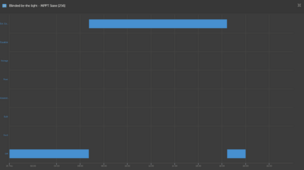
GX devices do not sync chargers. They can issue global limits, e.g., with DVCC, you can set voltage and current limits that the GX will pass through to all GX connected charge sources, but those are just numbers. It won't influence charge phase.
MPPT sync charging happens two ways:
- VE.Smart networking of Smartsolars capable of sync charging (a few old ones aren't).
- VE.CAN capable Smartsolar MPPT daisy chained together whether connected to a GX device or not. Up to 25 MPPT can be on the same chain.
GX does not provide MPPT sync even with DVCC enabled unless ESS and/or BMS control are active.
Per
https://www.victronenergy.com/media...tml#UUID-5e22b3c7-bb17-e103-9f5d-50a8f4147ad6
Even when DVCC is enabled, chargers are managed by their own internal algorithms.
Blatherings:
When all sources are very nearly equal power, there is a
slight tendency to stay in sync.
When all sources are using the same voltage/current data, there is a
slight tendency to stay in sync.
LFP battery absorption periods can be so short, you just never notice they're out of sync.
Lastly,
One can have as many independent charging sources running concurrently as they like provided they are programmed properly for the voltage of one's battery bank. Examples (some or all at once, even multiples of a single type, different brands, etc.): Solar PV via MPPT Solar PV via PWM AC-DC...

diysolarforum.com
Note:
Multiple chargers only offer benefit when the battery is below the absorption voltage. Once the absorption voltage is hit, it is now a voltage limited charge and thus current will be lower than the sum of all sources. The battery bank will only accept as much current as it needs to maintain the absorption voltage. As the battery bank fills, current is reduced and chargers can no longer deliver current at the absorption voltage. They will drop out and go to float. Typically, the highest current charging source will always be the last source charging while all others are at 0A and likely in float mode.
---
Going off equipment ratings, 50, 30, 15 and 15A, those are presumably proportional to the actual current each is capable of delivering...
Source 1: 3.3X min
Source 2: 2X min
Sources 3 and 4: min
In most cases, clear skies, all panels facing the same direction (i.e., all panels are experiencing the exact same solar intensity with no shading) 3 and 4 are likely to end up in float FAST, 2 is likely next and 1 will finish the charge.



